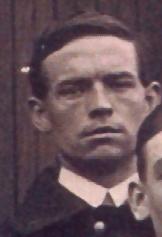BX April 12, 1915
Wounded in Two Places He Returns to Tell the Tale – Brant County Volunteer Back From the Front – Herbert Gauntlett, Who Left Here With Dufferin Rifles, Was Later Transferred to the Princess Patricia’s and Was Twice Wounded in the Fighting at Ypres
Herbert Gauntlett is Brant County’s first veteran to return from the war, badly wounded, and honorably discharged from the army because of his wounds. In the terrific fighting around Ypres he received a wound in the foot from bursting shrapnel, and he also received a wound in the shoulder from a German bayonet. After the wounds had partly healed during his stay at hospital in France, he received an honorable discharge, being invalided from the service.
Herbert Gauntlett is a young single man, a farm laborer, who resided before war broke out at Mount Pleasant. He had no previous military service, but when the call came he answered it. He joined the draft of men from the Dufferin Rifles sent to Valcartier after the first contingent from the regiment had gone there for training, the draft being to fill up the place of the men rejected for physical reasons.
Gauntlett secured his transfer from the 4th Battalion, of which the Dufferin Rifles’ Company now forms a part, he being sent with the Princess Patricia’s Light Infantry. With that splendid body of fighting men he went to the front, taking part in a number of strenuous engagements. It was while fighting with this regiment around Ypres, the Belgian town made famous by the gallant fight put up by the British army, that he received his wounds. The fighting around this town was the most desperate in which the British army took part after the turn of the tide, and the casualty list was very heavy. Gauntlett took a part and received a bayonet wound in the shoulder, while bursting shrapnel wounded his foot.
Gauntlett was sent down to the south of France to a military hospital, and there his wounds were treated, and he was discharged there on March 9. His physical condition was not such as to allow him to be of further use to the army, and he was sent home, arriving here on Saturday.
His mother, Mrs. Gauntlett, resided with Levi Beam, her son-in-law, on the McGill Street, Mount Pleasant Road.
The Hero’s Story
That there were but 58 left out of the entire battalion of some 1,800 men was the statement made by Pte. Gauntlett when seen this afternoon by an Expositor representative. Gauntlett still shows the effect of the grueling work which he has been through, coupled with the fact that he was twice wounded. His face is haggard, with care-drawn lines across it, while his limp is plainly perceptible, and he walks with some effort. His arm swings free, but he handles it with care, the wound in the shoulder not having entirely healed.
Joined Princess Pats
He stated that he had been assigned to the base company of the Duffs, as being one of the men who had not seen previous service, and though well set up physically, was not as thoroughly in touch with the work as the others. Not desiring to stay at the base for guard duties for some time when the other boys he knew were out in the thick of it, he transferred to the Princess Pats and was with them through the thick of the fighting. The trip across, he stated, was a long tedious one, and they were glad indeed when they reached the shores of old England. They were brigaded at Winchester, and after a period, were sent out to France, there to join the fighting line. For a time they were kept at the rear, until they were “blooded,” after which they went into the trenches with the British troops of the division of which they formed a part.
Received First Wound
The Princess Pat’s had done their share of the fighting, the casualties being very heavy. A charge had been ordered, and they went to it, with a will, and during the struggle Pte. Gauntlett had a German bayonet thrust through his shoulder, making the arm useless. It was impossible for him to leave the trenches after that to take part in any more advances, but he stayed in the trench for two days, after some first aid work had been done, and did his share of the work there. Two days after he received the wound in his shoulder the other men received orders to charge, and this they did. He remained behind, and he was not fit to take part in a charge, and while he was waiting back of the actual fighting line a German “Jack Johnson” burst, and parts crashed through his right foot. This completely put him out of business and he was taken to the rear, where his wound was carefully attended to. He was sent to a hospital in France, and was operated on for the wound in his foot. An electro-magnet was used to remove the particles of steel from the wound, and this was then carefully treated. On March 8 he was discharged from the hospital as cured. He made his way to London, thence to Bulford, the base of the Princess Pats, and to Tidworth, on Salisbury Plain, and from there returned back home.
Hospitals All Right
Pte. Gauntlett was loud in his praise of the hospital system of the British army. “They look after the fellow’s right,” he said, emphasizing the fact that everything that was needed was right at hand for use. In every way the men had been treated right from the time they left until the present. The only complaint that he had, and he felt that he was justified in making a kick, was that in landing in Canada he had been given an immigrant inspection ticket to show that he had been passed by the ship’s doctor as fit to land in Canada. As he is a Canadian, this touched him on the raw, and he feels yet very much aggrieved at the fact.
Sworn to Secrecy
Beyond the fact that the battalion had seen hard fighting, having been in the attacks around Ypres, Pte. Gauntlett would tell nothing of the movements of the battalion. “I took an oath that I would not tell anything, and I am not going to,” he said. Hence it was impossible to secure information as to what fights the Princess Pat’s had been in, in France and Belgium. The casualties had been very heavy, however.
Had Heard Rumors
He had not, he stated, heard from any of his friends with the 4th Battalion, to which he had belonged, and he was afraid that some of them, among them Jim Mounce, Steve Cara and Bill Dawson, had been wounded. He had, however, nothing on which to base this belief save that he had not heard from them for some time.
Left Uniform Behind
Pte. Gauntlett is not wearing his uniform, save for the Stetson broad hat which the Princess Pats wear.
When the Expositor representative expressed surprise at the number casualties he gave in the battalion, saying that that number had not come through, Pte. Gauntlett replied, “Do you think that they are telling all that they know over there? Not much.”
He regretted that he was out of the fighting now, but also expressed the opinion that he had had his share of wounds, if not of the fighting.

